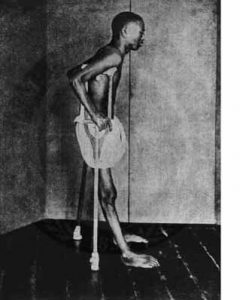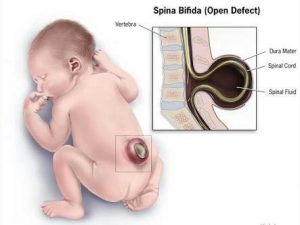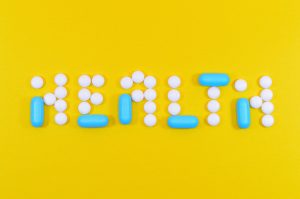12 Vitamins
Learn
- Discovery of vitamins
- Functions of water-soluble and fat-soluble vitamins
- Deficiency disorders associated with too much or too little intake of vitamins
- How supplements are approved for use
- Risks associated with taking supplements
Vitamins help your body carry out many functions. While your body can make some vitamins, others must come from the food you eat. There are two main categories for vitamins, water-soluble and fat-soluble. This chapter will explore each of the vitamins, how much you need, and the health implications of too much or too little.
Vitamin Overview
Watch this video for an introduction to vitamins.
Water-Soluble Vitamins
Water-soluble vitamins are ones that can dissolve in water. They are carried throughout the body into the tissues, but they are not stored in them. They get excreted when they are not needed, which means the body needs to get these more often to utilize them in the body. The water-soluble vitamins are made up of mainly vitamin C and the B complex vitamins.
Vitamin C
Vitamin C is also called ascorbic acid. Vitamin C functions to help with wound healing. It helps form collagen, an important protein in many body tissues. It also is known for aiding in the absorption of iron in the body. Vitamin C is very fragile, so it may be broken down or destroyed easily. Cooking (with high heat and for a long duration) and exposure to oxygen are two common instances where Vitamin C can be destroyed. Scurvy is the deficiency disease associated with vitamin C. Sailors who traveled on long voyages across the sea did not have access to fresh foods while on the water for an extended period of time. The sailors suffered from poor wound healing and bleeding gums, and in fact, many died. It was discovered that sailors who consumed citrus did were healthier and lived. Vitamin C is typically found in citrus, peppers, potatoes, papaya, kiwi, dark green, and yellow vegetables. The RDA for vitamin C is 75 mg for adult women and 90 mg for adult men.
Thiamine (B1)

Thiamine is essential in glucose metabolism. It acts as a cofactor for enzymes that break down glucose for energy production. Additionally, thiamine plays a role in the synthesis of ribose from glucose and is therefore required for RNA, DNA, and ATP synthesis. The brain and heart are most affected by a deficiency in thiamine. Thiamine deficiency, also known as beriberi, can cause fatigue, confusion, movement impairment, pain in the lower extremities, swelling, and heart failure. It is prevalent in societies whose main dietary staple is white rice. During the processing of white rice, the bran is removed, along with what were called in the early nineteenth century, “accessory factors,” vital for metabolism. Dutch physician Dr. Christiaan Eijkman cured chickens of beriberi by feeding them unpolished rice bran in 1897. The recommended intake for thiamine is 1.1 mg for females and 1.2 mg for males. Thiamine can be found in grains, wheat germ, pork, liver, salmon, black beans, and enriched foods.
Riboflavin (B2)
Riboflavin is an essential component of flavoproteins, coenzymes involved in many metabolic pathways of carbohydrate, lipid, and protein metabolism. Flavoproteins aid in the transfer of electrons in the electron transport chain. Furthermore, the functions of other B-vitamin coenzymes, such as vitamin B6 and folate, are dependent on the actions of flavoproteins. The “flavin” portion of riboflavin gives a bright yellow color to riboflavin, an attribute that helped lead to its discovery as a vitamin. Riboflavin deficiency, sometimes referred to as ariboflavinosis, is often accompanied by other dietary deficiencies (most notably protein) and can be common in people that suffer from alcoholism. Its signs and symptoms include dry, scaly skin, mouth inflammation and sores, sore throat, itchy eyes, and light sensitivity. The recommended intake is 1.1 mg for females and 1.3 mg for males. Riboflavin can be found in beef liver, kidneys, meat, milk, egg, green vegetables, and cheese.
Niacin (B3)
Niacin is a component of the coenzymes NADH and NADPH, which are involved in the breakdown and/or synthesis of carbohydrates, lipids, and proteins. NADH is the predominant electron carrier and transfers electrons to the electron-transport chain to make ATP. NADPH is also required for the anabolic pathways of fatty-acid and cholesterol synthesis. In contrast to other vitamins, niacin can be synthesized by humans from the amino acid tryptophan in an anabolic process requiring enzymes dependent on riboflavin, vitamin B6, and iron. Niacin is made from tryptophan only after tryptophan has met all of its other needs in the body. The contribution of tryptophan-derived niacin to niacin needs in the body varies widely, and a few scientific studies have demonstrated that diets high in tryptophan have minimal effect on niacin deficiency. Niacin deficiency is commonly known as pellagra and is characterized by diarrhea, dermatitis, dementia, and sometimes death. The recommended intake for niacin is 14 mg for women and 16 mg for men daily. Niacin containing foods are peanuts, ready-to-eat cereals, chicken, rice, yeast, and milk.
Pantothenic Acid (B5)
Pantothenic acid forms coenzyme A, which is the main carrier of carbon molecules in a cell. Acetyl-CoA is the carbon carrier of glucose, fatty acids, and amino acids into the citric acid cycle. Coenzyme A is also involved in the synthesis of lipids, cholesterol, and acetylcholine (a neurotransmitter). Vitamin B5 deficiency is exceptionally rare. Signs and symptoms include fatigue, irritability, numbness, muscle pain, and cramps. You may have seen pantothenic acid on many ingredient lists for skin and hair care products; however, there is no good scientific evidence that pantothenic acid improves human skin or hair. The recommended intake for pantothenic acid is 5 mg a day for an adult. Foods containing vitamin B5 are meats, fish, dairy, poultry, grains, and legumes.
Pyroxidine (B6)
Pyroxidine is the coenzyme involved in nitrogen transfer between amino acids and plays a role in amino-acid synthesis and catabolism. Also, it functions to release glucose from glycogen in the catabolic pathway of glycogenolysis and is required by enzymes for the synthesis of multiple neurotransmitters and hemoglobin. A deficiency in vitamin B6 can cause signs and symptoms of muscle weakness, dermatitis, mouth sores, fatigue, and confusion.
Vitamin B6 is a required coenzyme for the synthesis of hemoglobin. A deficiency in vitamin B6 can cause anemia, but it is of a different type than that caused by insufficient folate, cobalamin, or iron, although the symptoms are similar. The size of red blood cells is normal or somewhat smaller, but the hemoglobin content is lower. This means each red blood cell has less capacity for carrying oxygen, resulting in muscle weakness, fatigue, and shortness of breath. The recommended intake for pyroxidine is 1.3 mg per day for an adult. Foods containing vitamin B6 are pork, liver, wheat, corn, yeast, ready-to-eat cereals, banana, sweet potatoes, and avocados.
Cobalamin (B12)
Cobalamin contains cobalt, making it the only vitamin that contains a metal ion. Cobalamin is an essential part of coenzymes. It is necessary for fat and protein catabolism, folate coenzyme function, and hemoglobin synthesis. A folate-dependent enzyme needs an enzyme requiring cobalamin to synthesize DNA. Thus, a cobalamin deficiency has similar consequences to health as folate deficiency. In children and adults, cobalamin deficiency causes macrocytic anemia, and in babies born to cobalamin-deficient mothers, there is an increased risk for neural tube defects. Cells in the stomach secrete a protein called intrinsic factor necessary for cobalamin absorption, which occurs in the small intestine. Impairment of secretion of this protein either caused by an autoimmune disease or by chronic inflammation of the stomach (such as that occurring in some people with H.pylori infection), can lead to the disease pernicious anemia, a type of macrocytic anemia. Vitamin B12 malabsorption is most common in the elderly, who may have impaired digestive organs, a normal consequence of aging. Pernicious anemia is treated by large oral doses of vitamin B12 or by putting the vitamin under the tongue, where it is absorbed into the bloodstream without passing through the intestine. In patients that do not respond to oral or sublingual treatment, vitamin B12 is given by injection. The recommended intake for cobalamin is 2.4 mcg per day for an adult. Foods containing vitamin B12 are animal foods like meat, eggs, and dairy.
Biotin
Biotin is required as a coenzyme in the citric acid cycle and lipid metabolism. It is also required as an enzyme in the synthesis of glucose and some nonessential amino acids. A specific enzyme, biotinidase, is required to release biotin from protein to be absorbed in the gut. Biotin deficiency is rare but can be caused by eating large amounts of egg whites over an extended period of time. This is because a protein in egg whites tightly binds to biotin, making it unavailable for absorption. A rare genetic disease-causing malfunction of the biotinidase enzyme also results in biotin deficiency. Symptoms of biotin deficiency are similar to those of other B vitamins but may also include hair loss when severe. The recommended intake of biotin is 30 mcg a day for adults. Foods that contain biotin are liver, kidney, egg yolk, and yeast.
Folate
Folate is a required coenzyme to synthesize the amino acid methionine and make RNA and DNA. Therefore, rapidly dividing cells are most affected by folate deficiency. Red blood cells, white blood cells, and platelets are continuously being synthesized in the bone marrow from dividing stem cells. A consequence of folate deficiency is macrocytic, also called megaloblastic anemia. Macrocytic and megaloblastic mean “big cell,” and anemia refers to fewer red blood cells or red blood cells containing less hemoglobin. Macrocytic anemia is characterized by larger and fewer red blood cells. It is caused by red blood cells being unable to produce DNA and RNA fast enough—cells grow but do not divide, making them large in size.
Folate is especially essential for the growth and specialization of cells of the central nervous system. Children whose mothers were folate-deficient during pregnancy have a higher risk of neural-tube congenital disabilities. Folate deficiency is causally linked to the development of spina bifida, a neural-tube defect that occurs when the spine does not completely enclose the spinal cord.  Spina bifida can lead to many physical and mental disabilities. Observational studies show that the prevalence of neural-tube defects was decreased after the fortification of enriched cereal grain products with folate in 1996 in the United States compared to before grain products were fortified with folate. Results of clinical trials have demonstrated that neural-tube defects are significantly decreased in the offspring of mothers who began taking folate supplements one month before becoming pregnant and throughout the pregnancy. The RDA for folate is 600 mcg per day for pregnant women and 400 mcg for an adult. Food sources for folate include fortified dry cereal, liver, kidney beans, green leafy vegetables, brussels sprouts, and broccoli.
Spina bifida can lead to many physical and mental disabilities. Observational studies show that the prevalence of neural-tube defects was decreased after the fortification of enriched cereal grain products with folate in 1996 in the United States compared to before grain products were fortified with folate. Results of clinical trials have demonstrated that neural-tube defects are significantly decreased in the offspring of mothers who began taking folate supplements one month before becoming pregnant and throughout the pregnancy. The RDA for folate is 600 mcg per day for pregnant women and 400 mcg for an adult. Food sources for folate include fortified dry cereal, liver, kidney beans, green leafy vegetables, brussels sprouts, and broccoli.
Summary of the water-soluble vitamins
| B Vitamin | Function | Deficiency: Signs and Symptoms |
| B1 (thiamine) | Coenzyme: assists in glucose metabolism, RNA, DNA, and ATP synthesis | Beriberi: fatigue, confusion, movement impairment, swelling, heart failure |
| B2 (riboflavin) | Coenzyme: assists in glucose, fat and carbohydrate metabolism, electron carrier, other B vitamins are dependent on | Ariboflavinosis: dry, scaly skin, mouth inflammation and sores, sore throat, itchy eyes, light sensitivity |
| B3 (niacin) | Coenzyme: assists in glucose, fat, and protein metabolism, electron carrier | Pellagra: diarrhea, dermatitis, dementia, death |
| B5 (pantothenic acid) | Coenzyme: assists in glucose, fat, and protein metabolism, cholesterol and neurotransmitter synthesis | Muscle numbness and pain, fatigue, irritability |
| B6 (pyroxidine) | Coenzyme; assists in amino-acid synthesis, glycogenolysis, neurotransmitter, and hemoglobin synthesis | Muscle weakness, dermatitis, mouth sores, fatigue, confusion |
| Biotin | Coenzyme; assists in glucose, fat, and protein metabolism, amino-acid synthesis | Muscle weakness, dermatitis, fatigue, hair loss |
| Folate | Coenzyme; amino acid synthesis, RNA, DNA, and red blood cell synthesis | Diarrhea, mouth sores, confusion, anemia, neural-tube defects |
| B12 (cobalamin) | Coenzyme; fat and protein catabolism, folate function, red-blood-cell synthesis | Muscle weakness, sore tongue, anemia, nerve damage, neural-tube defects |
Lets Practice – Water Soluble Vitamins
Match the word in the correct statement.
Fat-Soluble Vitamins
Fat-soluble vitamins are ones that get dissolved in fat, also known as lipids. Unlike the water-soluble vitamins, these can be stored in the tissues to be used later. These do not need to be replenished in a healthy adult daily as the body can use what it stores. The fat-soluble vitamins include A, D, E, and K.
Vitamin A
Vitamin A has a wide variety of functions in the body. Some of the functions are to help with our skin, vision, reproduction,  and immune function. Vitamin A helps to enable the epithelial tissue (the thin outer layer of the body and the lining that protects your organs) and bone cells to form. Vitamin A is stored in the liver and adipose tissue of the body. Signs of deficiency of vitamin A typically relate to eye problems. One concern is nyctalopia, also known as night blindness. Other deficiencies are Xerophthalimia, dryness of the eye, and Bitott’s spots, keratinization of the eye’s conjunctiva. It is recommended to get 700 mcg for women and 900 mcg for vitamin A for men to avoid any concerns. Foods that contain vitamin A are orange vegetables like carrots and bell peppers. Kale, spinach, fish, and chicken.
and immune function. Vitamin A helps to enable the epithelial tissue (the thin outer layer of the body and the lining that protects your organs) and bone cells to form. Vitamin A is stored in the liver and adipose tissue of the body. Signs of deficiency of vitamin A typically relate to eye problems. One concern is nyctalopia, also known as night blindness. Other deficiencies are Xerophthalimia, dryness of the eye, and Bitott’s spots, keratinization of the eye’s conjunctiva. It is recommended to get 700 mcg for women and 900 mcg for vitamin A for men to avoid any concerns. Foods that contain vitamin A are orange vegetables like carrots and bell peppers. Kale, spinach, fish, and chicken.
Vitamin D
 Vitamin D is an important vitamin for our bones. Our body has the ability to turn UV light from the sun into vitamin D3 to be used in the body. The darker the skin tone, the less vitamin D is absorbed due to melanin’s surface level in darker skin tones. Bodies need vitamin D to absorb calcium and to build and maintain bone health. If someone is deficient in vitamin D, they are at risk for osteoporosis (low bone mass) or get rickets in children. Rickets is when the bones do not mineralize correctly. We can get vitamin D in our body through sunlight, fortified milk, salmon, or egg yolks. Recommendations for vitamin D is 15 mcg for adults.
Vitamin D is an important vitamin for our bones. Our body has the ability to turn UV light from the sun into vitamin D3 to be used in the body. The darker the skin tone, the less vitamin D is absorbed due to melanin’s surface level in darker skin tones. Bodies need vitamin D to absorb calcium and to build and maintain bone health. If someone is deficient in vitamin D, they are at risk for osteoporosis (low bone mass) or get rickets in children. Rickets is when the bones do not mineralize correctly. We can get vitamin D in our body through sunlight, fortified milk, salmon, or egg yolks. Recommendations for vitamin D is 15 mcg for adults.
Vitamin E
Vitamin E is an important antioxidant for the body. This vitamin helps to protect the cells from free radicals that are found in the body. The free radicals are produced from our bodies, converting food into energy. Vitamin E also helps to keep the skin moisturized and healthy. Hemolytic anemia may occur in deficient populations. Sources of vitamin E include sunflower seeds, almonds, peanuts, spinach, kiwis, and tomatoes. The recommended intake is 15 mg per day. This is not a very toxic vitamin, and the UI is 1,000 mg.
Vitamin K
Vitamin K is required for optimal bone metabolism and critical for blood function. It is a coenzyme for enzymes involved in blood clotting. Blood-clotting proteins are continuously circulating in the blood. Upon injury to a blood vessel, platelets stick to the wound forming a plug. The clotting factors circulating close by respond in a series of protein-protein interactions resulting in the fibrous protein’s formation, fibrin, which reinforces the platelet plug. There is no RDA or Ul for vitamin K; however, adult males need about 120 mcg per day, and adult females, 90 mcg per day.
A deficiency in vitamin K causes bleeding disorders. It is relatively rare, but people who have liver or pancreatic disease, celiac disease, or malabsorption conditions are at higher risk for vitamin K deficiency. Signs and symptoms include nosebleeds, easy bruising, broken blood vessels, bleeding gums, and heavy menstrual bleeding in women. The function of the anticoagulant drug warfarin is impaired by excess vitamin K intake from supplements. Calcium additionally plays a role in the activation of blood-clotting proteins.
How Did The Vitamins Get Their Name?
Exercise
Please answer the true or false questions.
Supplements

These are the most common supplements, according to the FDA:
- Calcium
- Echinacea
- Fish Oil
- Ginseng
- Glucosamine and/or
- Chondroitin Sulphate
- Garlic
- Vitamin D
- St. John’s Wort
- Saw Palmetto
- Ginkgo
- Green Tea
How are they approved?
Supplements are widely available in the United States. In 1994 the Dietary Supplement Health and Education Act (DSHEA) was approved and defined the term “dietary supplement” to mean a product (other than tobacco) intended to supplement the diet that bears or contains one or more dietary ingredients, including a vitamin, a mineral, an herb or other botanical, an amino acid, a dietary substance for use by man to supplement the diet by increasing the total dietary intake, or a concentrate, metabolite, constituent, extract or combination of any of the aforementioned ingredients. The FDA regulates and approves supplements that are sold to the general public. FDA regulates dietary supplements under a different set of regulations than those covering “conventional” foods and drug products. Dietary supplements are marketed as tablets, capsules, soft gels, gelcaps, powders, and liquids. The FDA only looks at the vitamin’s safety if it contains a new ingredient, not for the effectiveness, so the manufacturer needs to test its effectiveness.
For more information about vitamins, visit https://www.fda.gov/food/buy-store-serve-safe-food/what-you-need-know-about-dietary-supplements.
What are the risks?
There can be many risks to taking vitamins, as it does contain active ingredients. Some of the common risks include:
- Combining supplements
- Using supplements with medicines (whether prescription or over-the-counter)
- Substituting supplements for prescription medicines
- Taking too much of some supplements, such as vitamin A, vitamin D, or iron
Some supplements can also have unwanted effects before, during, and after surgery. So, be sure to inform your healthcare provider, including your pharmacist, about any supplements you are taking.
How to protect yourself
If supplements are needed, it is best to speak with a doctor before purchasing the supplement to ensure no consumption concerns. When buying supplements online, it is best to buy off a noncommercial website as some sellers online may have a misleading website or have misleading labels. Be aware of claims that a supplement may work better than a prescription drug or that it has no side effects. Always keep in mind that advertising on supplement labels is not regulated.
Learning Objectives
- Explain the history of vitamins. (MCCCD Competency 1)
- Explain the functions of water-soluble and fat-soluble vitamins. (MCCCD Competency 5)
- Summarize deficiency disorders associated with too much or too little intake of vitamins. (MCCCD Competency 5)
- Discuss how supplements are approved for use. (MCCCD Competencies 1 & 2)
- Identify risks associated with taking a supplement. (MCCCD Competency 6)

